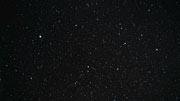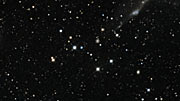Pressmeddelande
“Atomer för fred”: En galaktisk kollision pågår
10 november 2010
Astronomer vid Europeiska sydobservatoriet (ESO) har skapat en spektakulär ny bild av den berömda Atomer för fred-galaxen, som även kallas NGC 7252. Denna galaktiska hopslagning efter en kollision mellan två galaxer ger ett utmärkt tillfälle för astronomerna att studera hur sammansmältande galaxer påverkar universums utveckling.
Bland de processer som påverkar hur universum utvecklas är kollisioner mellan galaxer en av de viktigaste. För astronomerna ger sådana krockar viktiga ledtrådar till varifrån galaxerna kommer. Turligt nog är dessa kollisioner utdragna händelser som pågår i miljontals år, vilket ger forskarna gott om tid att observera dem.
Den här bilden på “Atomer för fred” ger en ögonblicksbild av en kollision i all sin kaotiska prakt, mot en fond av otaliga, avlägsna galaxer. De långa svansarna, som består av strömmar av stjärnor, gas och stoft, skvallrar om det intrikata samspelet mellan galaxerna, styrt av tyngdkraften. Bilden visar även de märkliga skal som bildades när gas och stjärnor revs ur de kolliderande galaxerna för att sedan åter linda sig runt deras nya, gemensamma kärna. Medan mängder av materia sköts ut i rymden trycktes andra områden samman, med följden att nya utbrott av stjärnbildning utlöstes. Resultatet var att hundratals mycket unga stjärnhopar skapades, som nu är mellan 50 och 500 miljoner år gamla. Enligt forskare kan dessa vara föregångare till de täta, runda stjärnklungor som kallas klothopar.
“Atomer för fred”-kollisionen kanske berättar något om framtiden för vår galax. Astronomer förutspår att om tre till fyra miljarder år kommer Vintergatan och dess granne Andromedagalaxen att kollidera, på ungefär samma sätt som “Atomer för fred”. Men det finns inga skäl till panik. Avstånden mellan stjärnorna inuti en galax är så enorma att det är mycket osannolikt att solen hamnar i en frontalkrock under sammangåendet.
Objektets underliga smeknamn har en intressant historia. I december 1953 höll USA:s dåvarande president Eisenhower ett tal som blev känt som “Atomer för fred”. Dess tema var att främja kärnkraften för fredliga ändamål - ett på den tiden hett ämne. Talet och konferensen där den hölls till fick efterdyningar såväl i forskarsamhället som utanför, så pass att NGC 7252 kallades “Atomer för fred”-galaxen. Namnet är faktiskt märkligt passande. Den underliga formen som vi ser, resultatet av två galaxer som smälter samman för att skapa något nytt och mäktigt, för kanske tankarna till kärnfusion. Dessutom påminner jätteöglorna om ett läroboksdiagram över elektroner som kretsar kring en atomkärna.
Mer information
ESO, Europeiska sydobservatoriet, är Europas främsta samarbetsorgan för astronomisk forskning och världens mest produktiva astronomiska observatorium. Det stöds av 14 länder: Belgien, Danmark, Finland, Frankrike, Italien, Nederländerna, Portugal, Schweiz, Spanien, Storbritannien, Sverige, Tjeckien, Tyskland och Österrike. ESO:s ambitiösa verksamhet rör design, konstruktion och drift av avancerade markbaserade forskningsanläggningar som gör det möjligt för astronomer att göra banbrytande vetenskapliga upptäckter. ESO spelar dessutom en ledande roll i att främja och organisera samarbeten inom astronomisk forskning. ESO driver tre unika observationsplatser i Chile: La Silla, Paranal och Chajnantor. Vid Paranal finns Very Large Telescope, världens mest avancerade observatorium för synligt ljus, och VISTA, det största kartläggningsteleskopet. ESO bidrar dessutom till ALMA, ett revolutionerande astronomiskt teleskop och världens hittills största astronomiska projekt. ESO planerar för närvarande bygget av ett 42-meters europeiskt extremt stort teleskop för synligt och infrarött ljus, E-ELT, som kommer att bli ”världens största öga mot himlen”.
Kontakter
Richard Hook
ESO, La Silla, Paranal, E-ELT and Survey Telescopes Public Information Officer
Garching bei München, Germany
Tel: +49 89 3200 6655
Mobil: +49 151 1537 3591
E-post: rhook@eso.org
Johan Warell (Presskontakt för Sverige)
ESO:s nätverk för vetenskaplig kommunikation
Skurup, Sverige
Tel: +46-706-494731
E-post: eson-sweden@eso.org
Om pressmeddelandet
| Pressmeddelande nr: | eso1044sv |
| Namn: | NGC 7252 |
| Typ: | Milky Way : Galaxy : Type : Interacting |
| Facility: | MPG/ESO 2.2-metre telescope |
| Instruments: | WFI |
Our use of Cookies
We use cookies that are essential for accessing our websites and using our services. We also use cookies to analyse, measure and improve our websites’ performance, to enable content sharing via social media and to display media content hosted on third-party platforms.
ESO Cookies Policy
The European Organisation for Astronomical Research in the Southern Hemisphere (ESO) is the pre-eminent intergovernmental science and technology organisation in astronomy. It carries out an ambitious programme focused on the design, construction and operation of powerful ground-based observing facilities for astronomy.
This Cookies Policy is intended to provide clarity by outlining the cookies used on the ESO public websites, their functions, the options you have for controlling them, and the ways you can contact us for additional details.
What are cookies?
Cookies are small pieces of data stored on your device by websites you visit. They serve various purposes, such as remembering login credentials and preferences and enhance your browsing experience.
Categories of cookies we use
Essential cookies (always active): These cookies are strictly necessary for the proper functioning of our website. Without these cookies, the website cannot operate correctly, and certain services, such as logging in or accessing secure areas, may not be available; because they are essential for the website’s operation, they cannot be disabled.
Functional Cookies: These cookies enhance your browsing experience by enabling additional features and personalization, such as remembering your preferences and settings. While not strictly necessary for the website to function, they improve usability and convenience; these cookies are only placed if you provide your consent.
Analytics cookies: These cookies collect information about how visitors interact with our website, such as which pages are visited most often and how users navigate the site. This data helps us improve website performance, optimize content, and enhance the user experience; these cookies are only placed if you provide your consent. We use the following analytics cookies.
Matomo Cookies:
This website uses Matomo (formerly Piwik), an open source software which enables the statistical analysis of website visits. Matomo uses cookies (text files) which are saved on your computer and which allow us to analyze how you use our website. The website user information generated by the cookies will only be saved on the servers of our IT Department. We use this information to analyze www.eso.org visits and to prepare reports on website activities. These data will not be disclosed to third parties.
On behalf of ESO, Matomo will use this information for the purpose of evaluating your use of the website, compiling reports on website activity and providing other services relating to website activity and internet usage.
Matomo cookies settings:
Additional Third-party cookies on ESO websites: some of our pages display content from external providers, e.g. YouTube.
Such third-party services are outside of ESO control and may, at any time, change their terms of service, use of cookies, etc.
YouTube: Some videos on the ESO website are embedded from ESO’s official YouTube channel. We have enabled YouTube’s privacy-enhanced mode, meaning that no cookies are set unless the user actively clicks on the video to play it. Additionally, in this mode, YouTube does not store any personally identifiable cookie data for embedded video playbacks. For more details, please refer to YouTube’s embedding videos information page.
Cookies can also be classified based on the following elements.
Regarding the domain, there are:
- First-party cookies, set by the website you are currently visiting. They are stored by the same domain that you are browsing and are used to enhance your experience on that site;
- Third-party cookies, set by a domain other than the one you are currently visiting.
As for their duration, cookies can be:
- Browser-session cookies, which are deleted when the user closes the browser;
- Stored cookies, which stay on the user's device for a predetermined period of time.
How to manage cookies
Cookie settings: You can modify your cookie choices for the ESO webpages at any time by clicking on the link Cookie settings at the bottom of any page.
In your browser: If you wish to delete cookies or instruct your browser to delete or block cookies by default, please visit the help pages of your browser:
Please be aware that if you delete or decline cookies, certain functionalities of our website may be not be available and your browsing experience may be affected.
You can set most browsers to prevent any cookies being placed on your device, but you may then have to manually adjust some preferences every time you visit a site/page. And some services and functionalities may not work properly at all (e.g. profile logging-in, shop check out).
Updates to the ESO Cookies Policy
The ESO Cookies Policy may be subject to future updates, which will be made available on this page.
Additional information
For any queries related to cookies, please contact: pdprATesoDOTorg.
As ESO public webpages are managed by our Department of Communication, your questions will be dealt with the support of the said Department.





